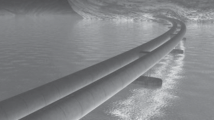Abstract
The article is devoted to development and application of mathematical models describing the most dangerous mechanisms through which vibrations are excited in tube bundles and blunt cylindrically shaped structures, and to development of reliable calculation methods for describing these models, which would make it possible to obtain prompt data for designing and subsequent operation of the considered structural elements. For solving such problems, a comprehensive approach is required, which should be based on a combined use of numerical experiments on computers and experimental investigations on full-scale equipment. The authors have developed a procedure for numerically investigating the hydrodynamic forces arising during stalled streamlining and the tube bundle vibrations caused by these forces. The procedure is based on using the developed mathematical model describing fluid-elastic excitation of vibrations in a bundle of elastic tubes placed in external cross flow. The problem of studying fluid-elastic excitation is brought to stability analysis, which is carried out with the assumption about a linear behavior of destabilizing forces for undisturbed state of elastic tubes. A theoretical investigation of the developed mathematical model was carried out, from which the necessary and sufficient condition of system stability has been obtained in terms of system dimensionless parameters (mass, damping, and velocity). An algorithm for numerically determining the matrices of linear hydrodynamic coupling coefficients for particular tube bundles is developed. The validity of the algorithm and the computer programs developed on its basis are checked by comparing the results of test calculations with the bank of known experimental data. A procedure is proposed for determining the matrices of linear hydrodynamic coupling coefficients in bundles having a regular layout of their cross section and a large number of tubes through calculating these matrices for a relatively small but sufficiently representative fragment of such bundle. The values of critical coolant velocity are determined as a function of a dimensionless parameter incorporating the logarithmic decrement of vibrations and the dimensionless bundle mass parameter.
Similar content being viewed by others
References
P. R. Andronov, S. V. Guvernyuk, and G. Ya. Dynnikova, Vortex Methods for Calculating Unsteady Hydrodynamic Loads (MGU, Moscow, 2006) [in Russian].
O. A. Ivanova, “Numerically modeling the capture effect of vortices shedding from a vibrating profile,” in Proceedings of the 15th International Symposium “Methods of Discrete Singularities in Mathematical Physics Problems” (Kherson, Kharkov, 2011), pp. 193–196.
I. K. Marchevskii and O. A. Ivanova, “Numerical modeling of the circular profile wind resonance using the vortex element method,” Probl. Mashinostr. Nadezhn. Mashin, No. 5, 8–12 (2009).
N. G. Val’es, A. V. Masevich, and A. V. Samolysov, “Calculating vortex streamlining of fixed and vibrating cylindrical bodies using the discrete vortex method,” Vestn. Nauch.-Tekhn. Razv., No. 6, 31–37 (2014).
N. G. Val’es, A. V. Masevich, and A. V. Samolysov, “Applying the discrete vortex method for calculating stalled streamlining of one- and two-component structures,” Probl. Mashinostr. Autom., No. 3, 42–45 (2013).
N. Ya. Nikolaev and L. V. Smirnov, “About the mathematical model of fluid-elastic excitation of vibrations in a bundle of elastic tubes in cross flow,” in Applied Problems of Strength and Plasticity. Statics and Dynamics of Deformable Systems (Gorky Gos. Univ., Gorky, 1985), pp. 118–126.
S. S. Czhen, “Mechanism governing the occurrence of instability for a group of round cylinders subjected to cross flow. Part 1,” Trans. of ASME, J. Eng. Ind. 105(1), 16–24 (1983).
R. Blewins, “Fluidelastic vortex vibrations of single rows and bundles of tubes,” Trans. of ASME, J. Basic Eng., No. 3, 109–115 (1977).
H. Tanaka, “Study on fluidelastic vibration tube bundles (single row of cylinders),” Trans. JSME 46(408), 1398–1404.
H. J. Connors, “Fluidelastic vibration of tube arrays excited by cross flow,” in Proceedings of the Symposium of ASME Winter Annual Meeting “Flow-Induced Vibration in Heat Exchanger,” New York, 1970, pp. 42–56.
Author information
Authors and Affiliations
Corresponding author
Additional information
Original Russian Text © S.M. Kaplunov, N.G. Val’es, A.V. Samolysov, O.A. Marchevskaya, 2015, published in Teploenergetika.
Rights and permissions
About this article
Cite this article
Kaplunov, S.M., Val’es, N.G., Samolysov, A.V. et al. Determining the tube bundle streamlining critical parameters using the numerical experiment method. Therm. Eng. 62, 593–597 (2015). https://doi.org/10.1134/S0040601515080029
Published:
Issue Date:
DOI: https://doi.org/10.1134/S0040601515080029



